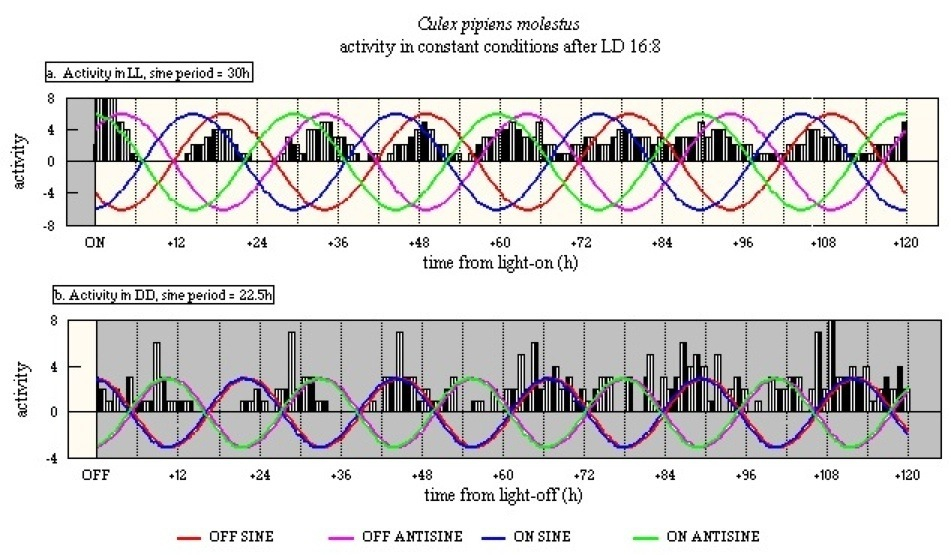
Biological Clocks in Mosquitoes - Section 2
The underlying mechanisms - how many clocks and why are they circadian?
|
Evidence from studies of Culex pipiens molestus
Studies on members of the Culex pipiens complex, by Chiba and
his colleagues in Japan, comprise one of the most comprehensive
research programmes on circadian rhythms and photoperiodism. A recent
study of Cx. p. molestus (Chiba & Tomioka, 1992) examined
the response to changing the LD ratio from a standard rearing regime of
LD 16:8, representative of the Summer conditions in Iran, from where
the colony had originated. Cx. p. molestus was chosen
because it displays flight activity in both light and dark. In DD t @ 22.5h, which is identical to that found for Ae. aegypti,
but in LL Cx. p. molestus was thought to have a
periodicity of t @ 15.5h (SD+/-1.2h). By
extrapolation from the published graphs of activity, histograms of
activity (using an arbitrary scale) in LL and DD are shown in Figure 36.
Figure 36

The four hypothetical sine waves are superimposed on the histograms.
For this species, and for the other day-active species (which follow
below), each wave is plotted with an arbitrary maximum value of 6.0 in
L and 3.0 in D. For the LL graph (see Figure 36a) a sine t = 30h has been used, and for the DD
graph (see Figure 36b) a sine t
= 22.5h has been used. It is obvious from both graphs that most of
the observed peaks match a peak of one of the sine waves; but an even
better fit can be seen between lowest points of activity and the times
where all four sine waves are around zero. The sine waves are plotted
on the basis of there having been a dark period (D8) before the
light-on in LL, and a light period (L16) before the light-off in DD. It
is clear that the interpretation of Chiba & Tomioka (1992) of an LLt = 15.5h may well be the manifestation
of separate oscillators each with t @ 30-31h.
This introduces a new element to the concept and that is that although
DDt appears to be the same for both Cx. p. molestus
and Ae. aegypti, the LLt of the
two species differs.
 NEXT
NEXT

©1998, 2010 - Brian Taylor CBiol FSB FRES
11, Grazingfield, Wilford, Nottingham, NG11 7FN, U.K.
Comments to dr.b.taylor@ntlworld.com
|
href="\crhtml\clocks5.htm"


